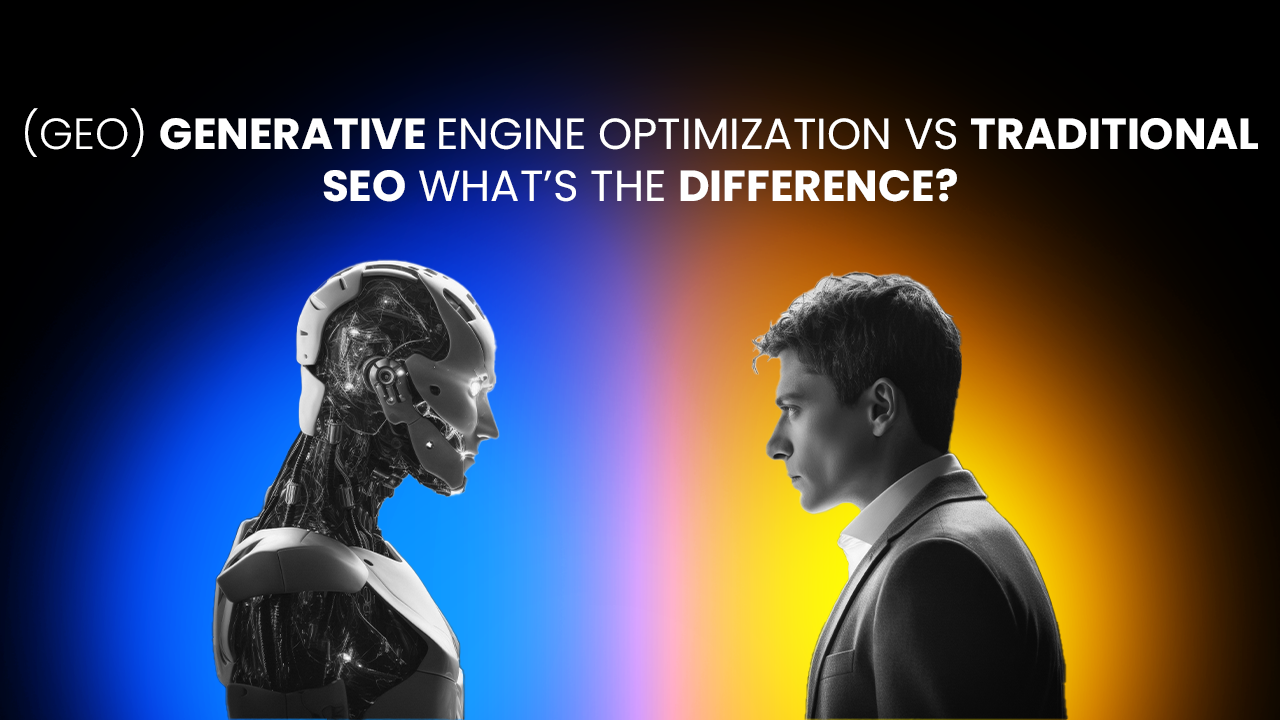Generative Engine Optimization vs Traditional SEO – What’s the Difference?
Published on: 12 November, 2025

While AI reshapes how online spaces work, Generative Engine Optimization – often called GEO – is becoming a fresh take on reaching people through search. This detailed look breaks down GEO compared to classic SEO, highlights key contrasts, and also shows what companies from different areas should consider adapting as AI transforms how searches happen. Once you finish reading, you’ll understand what sets generative engine optimization apart from classic SEO – where they clash, where they match up, yet also grasp why smart companies are already shifting focus toward GEO right now.
Understanding the Evolution of Search: From Keywords to Intelligence
Search tweaks used to just mean picking the right words. Old-school methods leaned hard on page labels, links from other sites, or stuffing posts with phrases – all aimed at showing up higher in Google. But once smart systems like Google’s SGE and Bing’s Copilot showed up, how people find stuff online shifted – fast.
Old-school search engines scanned web pages then sorted them based on how closely they matched your query – today’s AI-powered tools go further, understanding context, pulling key points, or even creating fresh answers through smart processing. That change calls for a totally different approach to tweaking content – one designed for systems that process ideas instead of simply scanning links
In simple terms:
- Old-school SEO means tweaking stuff so bots can find it.
- Generative Engine Optimization (GEO) means shaping content so AI-powered tools can use it to give answers.
This shift changes things for marketers aiming to keep up as voice searches grow more common – so standing out gets tougher unless they adapt fast.
What Is Generative Engine Optimization (GEO)?
Generative Engine Optimization (GEO) means shaping web content so it works well with AI-driven tools like ChatGPT Search, Google SGE, Perplexity.ai, or Bing Copilot. Instead of showing links one after another, these systems pull info from various sites then craft a blended reply on their own.
Instead of chasing high search spots like regular SEO does, GEO’s about teaching artificial brains to spot your name, mention your site, or pull pieces from your pages when they sum things up.
Here’s what sets it apart:
- GEO wants to show up when AI answers questions, not only grab a spot on search results.
- It improves organized info plus meaning so machines can understand better.
GEO needs content built smart, better schemas, also designs that fit how AI sees things – nothing like old-school SEO fixated on links.
Traditional SEO: Proven but Limited in the AI Era
Old-school SEO still matters – yet it’s built around rankings, not logic. Instead of smarts, it leans on tech tricks or solid content to prove trustworthiness to Google.
Traditional SEO typically includes:
- Fix page titles along with meta descriptions – tweak how often words pop up across the content.
- Links from other sites, shares on social media, mentions of your brand.
- Fast loading pages, good for phones, easy for bots to scan around.
However, traditional SEO faces new challenges:
- Smart systems pull together details, so fewer people follow links.
- Some generative systems could skip page rankings completely.
So, even though old-school seo services provider in karachi help you get seen at first, it doesn’t always lead to being found when AI runs the search game now.
Key Differences: Generative Engine Optimization vs Traditional SEO
Understanding the generative engine optimization vs traditional SEO differences is crucial for modern digital marketers.
| Traditional SEO | Generative Engine Optimization (GEO) |
| Goal: Rank higher on search results pages | Appear in AI-generated summaries |
| Focus: Keywords, backlinks, authority | Context, semantics, data structures |
| Optimization Target: Search engines | Generative AI models |
| Tools: Google Search Console, Ahrefs | OpenAI, SGE, Schema Builders |
| Measurement: Rankings, CTR, traffic | Mentions in AI answers, citation frequency |
| Content Strategy: Informational + transactional keywords | Contextual + conversational knowledge |
In short, Traditional SEO optimizes for humans using search, while GEO optimizes for AI generating answers for humans.
Why Generative Engine Optimization Matters
As AI-powered search grows fast, GEO’s turning into something more businesses can’t ignore. Tools such as ChatGPT’s online lookup, Perplexity, or Google’s SGE tend to favor sites they find reliable – ones that make sense to them meaning-wise.
One big plus? It saves time. Another good thing – cuts down effort:
- Greater trust in your name – GEO helps AI see your company as dependable.
- Better exposure from AI snippets – showing up in responses boosts your presence, even if folks never tap the link.
Businesses facing tough competition – like those offering SEO in Karachi – need to tweak how their website talks to people as well as algorithms. Instead of sticking to old methods, they might try fresh wording that clicks with readers while still making sense to machines scanning the page.
Jumping on GEO now means your stuff helps shape how upcoming AI systems see info – so they’ll recognize you even outside regular search results.
GEO vs Traditional SEO in Multiple Regions
Generative Engine Optimization doesn’t work the same everywhere. Because regional search platforms see what users want in their own way. You need local context, grasp of native speech patterns, also AI cues trained on cultural and language backgrounds.
For example:
- In South Asia, AI search could favor Urdu or Hindi questions from locals – though it might depend on usage – or simply follow regional trends instead.
- In North America, the focus leans on clear frameworks alongside trusted references.
Old-school SEO just swaps words from one language to another – yet GEO goes deeper by capturing intent, so machines grasp where you actually matter. When companies work in various countries, that’s what sets apart smart search strategies today compared to outdated keyword fixes spread across borders.
Implementing Generative Engine Optimization (Step-by-Step Overview)
Getting started with GEO means mixing SEO know-how, understanding AI, or working with smart content structures.
Try this real-world method instead:
- Check what you already wrote – look at the posts that got the most attention, then see how smart software breaks them down.
- Focus on things, not just words. Try using labels like Company, Human, Item, or Questions so machines get what you mean.
- Ask stuff like a person would – set it up like real talk or back-and-forth chat, since those smart tools respond best when they’re in a convo flow.
- Set up trusted references by sharing knowledge from specialists, studies, or confirmed facts that artificial intelligence systems might reference.
- Try typing your subject into ChatGPT, then check Perplexity – see if your page shows up. After that, jump over to SGE and have a look around there too.
Switching from SEO to GEO isn’t about ditching what worked before – think of it as upgrading those tools so they fit better in today’s AI-powered search world.
How AI-Driven Search Impacts CTR and Organic Traffic
Generative search changes how people use the web – big time. Rather than swiping past a list of dull links, folks get chatty, summarized replies right away. Old-school SEO used to bank on CTRs for success. But now, since AI hands out instant answers, fewer users actually click through, ending up in what some call “search without clicking.”.
GEO cuts down on this issue by making sure that:
- Your brand shows up in AI responses – even if no one clicks through.
- People notice your company’s name showing up in quick overviews, then remember it later because it sticks around.
This type of subtle exposure keeps your name front-loaded – key for companies selling services, especially firms in Karachi that focus on online promotion or search engine ranking help.
GEO and AI-Driven Content Creation
GEO works better when paired with AI helpers. Instead of crafting content yourself, try using ChatGPT, Gemini, or Claude to spark ideas and fine-tune entities – this speeds up setting up GEO. It’s not about replacing your voice, rather adjusting how machines interpret it.
Integrate GEO with your content workflow:
- Create clear plans that tackle several connected queries at once.
- Use schema tags so computers can understand the data.
- Teach AI through regular posts that show your brand’s voice and know-how – using steady updates builds smarts over time because practice shapes performance.
This forward-thinking approach helps generative tools pick up on your tone – instead of someone else’s.
Commercial Opportunities with GEO
Businesses offering SEO in Karachi might find GEO a smart way to grow. Since customers now want results that work with AI, agencies could try this path instead:
- Run location checks: see how companies show up in smart search tools.
- Build smart citation strategies using AI – helps get picked more in auto-generated replies.
- Use old-school SEO along with local targeting to grow in a mixed way.
Foresighted teams blending these skills will lead the coming ten years in search promotion – by staying sharp, adapting fast.
Challenges in Adopting Generative Engine Optimization
Switching to GEO can be tricky. Because many AI search tools still lack built-in stats views, tracking results gets messy – on top of that.
- It’s hard to see exactly how AI picks and references info.
- Frequent changes to how generative models work can throw off any attempt to fine-tune them.
Still, like old-school SEO folks who tweaked tactics when Google changed things, today’s promoters need to try out, check, then tweak GEO methods to keep up.
The Future of Search: GEO + SEO Hybridization
The top brands don’t pick sides – geo or classic seo – they mix them instead. Classic SEO helps your site show up while keeping things running smooth – without glitches piling up. GEO helps AI get what you know, while using it as a guide.
This connection brings complete clarity, linking search engine strength with smart tech insight – over time, GEO alongside old-school SEO won’t clash but fit together like pieces of one plan to stay visible where people look and where machines answer.
To Wrap Things Up: Evolve Beyond Rankings
The discussion on Generative Engine Optimization compared to old-school SEO isn’t swapping one for the other – it’s more like moving forward. With AI changing how people search, companies need to shift away from chasing rankings toward building meaningful connections.
Your brand gets ahead when clear data works with smart content plus real know-how, especially where location meets AI-powered searches. No matter if you’re running SEO services in Karachi or handling big-scale operations worldwide, staying sharp means jumping on Generative Engine Optimization early – well before it’s normal.
FAQ’s
1. What is the main difference between Generative Engine Optimization (GEO) and Traditional SEO?
Old-school SEO tweaks sites for Google by targeting keywords, links, and page setup. Meanwhile, GEO shapes content so AI tools like ChatGPT or Claude pick your brand when giving answers.
2. Why is Generative Engine Optimization important in 2025?
People now use AI helpers more than Google to find info. So if your content isn’t built clearly, organized well, or tied to key topics, it won’t show up when bots generate replies – meaning less visitors and fewer potential customers.
3. Can GEO and Traditional SEO work together?
Yep, totally. GEO boosts how often your brand shows up in AI responses, whereas regular SEO gets your site higher on search results. Companies using both – mixing the two – tend to lead in standard Google listings as well as answers made by artificial intelligence.
4. How does GEO improve brand visibility compared to Traditional SEO?
GEO works with smart content that fits how AI thinks, linking real-world things to data, organizing ideas clearly, and keeping facts straight—so bots can mention your brand without forcing it. Old-school SEO leans way too much on stuff like links from other sites, site speed tweaks, trust signals, or guessing what words people type.
5. What type of content performs best for Generative Engine Optimization?
AI prefers:
- Entity-based content
- FAQ-style structured answers
- Clear definitions
- Comparison tables
- Step-by-step guides
- Factual stuff, backed up with solid references
This stuff’s simpler for AI systems to grasp when crafting replies because they can work with it more naturally.




